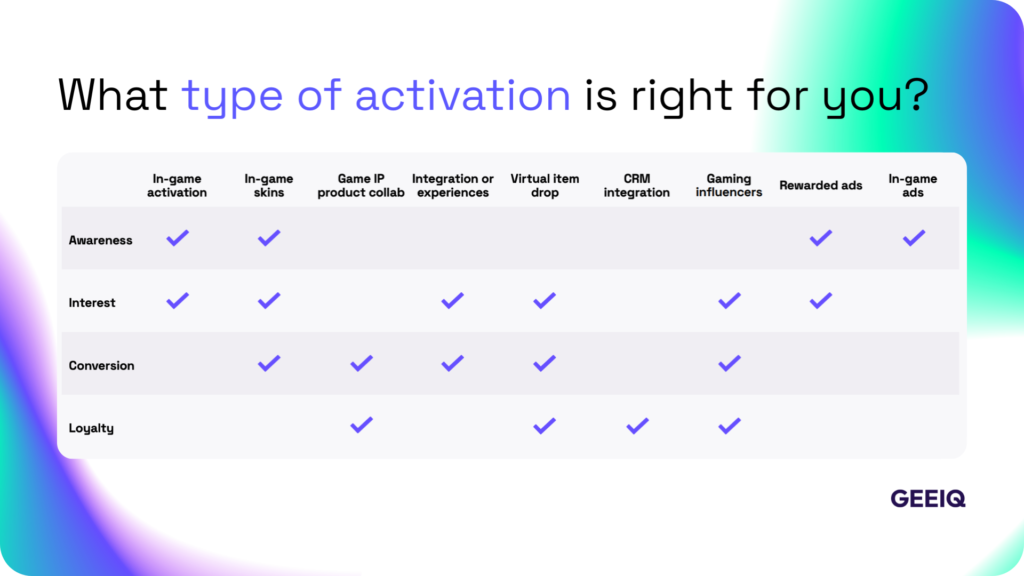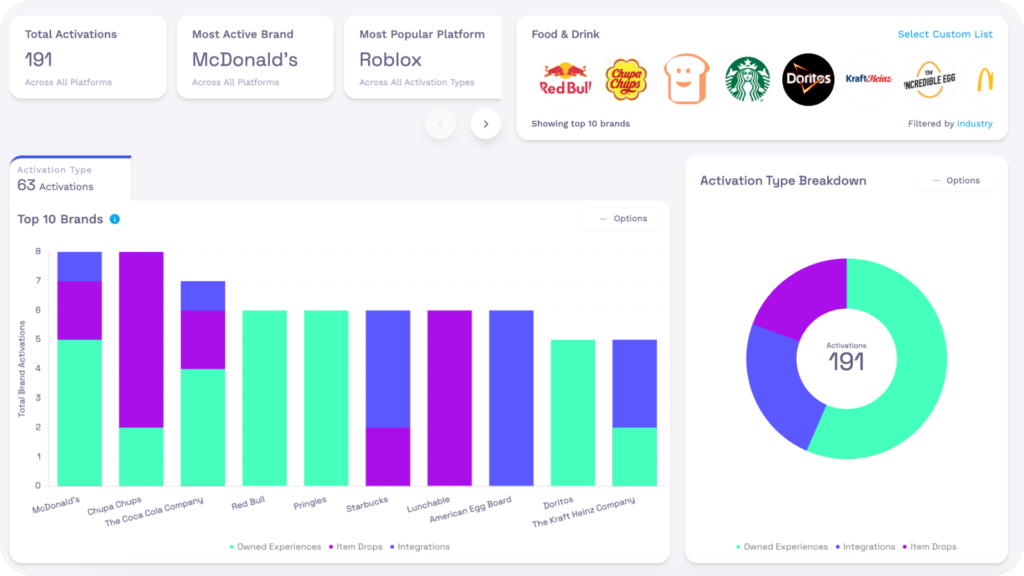Discover how to conduct a competitor analysis in gaming for your brand or client in virtual worlds and gaming.
In the fast-moving world of gaming and virtual worlds, keeping an eye on the competition is essential. Last year alone, 558 brands launched activations across platforms like Roblox, Fortnite, ZEPETO, and Minecraft. The space is no longer driven by novelty. It is crowded, competitive, and strategic. If you want to stand out, you need to know who you’re up against.
In this article, we’ll cover exactly where to start with your competitor analysis in gaming, including how to get the strategic insights you need to win.
Let’s get started. 👇
What is competitor analysis?
A competitor analysis identifies how other brands position themselves. For example, what platforms they’re using, what they’re launching, and how audiences are engaging. A competitor analysis in gaming means tracking platform choices, activation types, player engagement, and outcomes. This intelligence helps sharpen your strategy and secure internal buy-in.
Why does competitor analysis matter in gaming?
A competitor analysis in gaming gives you the intelligence you need to lead, not follow. Deniz Ronayne, who works with brands and studios like NASCAR, Dubit, and Karta, expands on this. 👇
Unlike with a social media competitor analysis, it is hard to gather data on your competitors in virtual worlds. You can sink hours into trying to find a competitor’s activations through press articles or LinkedIn posts. Not to mention, the private nature of gaming data means it’s difficult to gauge whether your competitors’ virtual activation was successful.
That’s where competitor analysis in gaming becomes essential. It gives you the strategic edge to:
- Understand how others bring their brand to life through items, integrations, or gameplay mechanics.
- Find gaps and new opportunities where you can stand out.
- Benchmark performance with meaningful engagement metrics.
In a space that’s growing more crowded and competitive each year, competitive intelligence isn’t a nice-to-have. It’s a necessity.
How to do a competitor analysis in gaming

1. Define your goals.
Start with clarity. What does success look like to your team? Is it awareness, engagement, item sales, or loyalty signups? Your goals should guide how you interpret competitor activity.
For example, Paris Hilton’s 11:11 Media and Hilton Hotels activated on Roblox to drive loyalty sign-ups for the Hilton Honors program. GEEIQ’s Competitor Analysis tool shows that other entertainment IPs, like TWICE or Nicki Minaj, tend to focus on item drops. That’s an effective tactic for boosting engagement, but not necessarily conversions. Rather than following the crowd, 11:11 Media and Hilton chose a strategy aligned with their specific goals, uncovering a new opportunity that better served their objectives. The result? Over 27,000 email sign-ups to the loyalty program through Roblox.
Defining clear goals from the start helps you analyze competitor activity through the right lens and choose a strategy that drives the outcomes that matter most to your brand.
2. Identify your competitors.

Your biggest threat in virtual worlds might not be your usual industry rival.
In the real world, McDonald’s competes with brands like Burger King and Wendy’s. But in virtual worlds, the landscape looks different. McDonald’s leads the Food & Drink category with eight virtual activations, tied with Chupa Chups and just ahead of Coca-Cola, which has seven. That makes Chupa Chups and Coca-Cola stronger contenders for a share of player attention in gaming environments.
Of course, volume alone doesn’t always equal impact. That’s where performance metrics like visits, engagement, and retention give a fuller picture. These metrics help you understand who’s making noise and who’s actually connecting with the audience you’re after.
Consider segmenting your competitors into the following:
- Direct real-world competitors: Traditional rivals from your industry.
- Direct virtual competitors: Brands in your industry that are already active in virtual worlds.
- Indirect competitors: Out-of-category brands targeting the same audience or gaming platforms as you.
Segmenting your competitors like this helps you understand which brands to track, learn from, or outmaneuver, depending on your strategic goals.
3. Analyze your competitors’ virtual strategy.
Once you know who to watch, examine where and how they show up in gaming. Are they building owned experiences? Launching virtual items? Partnering with creators? What’s their strategy’s balance between integrations, owned experiences, and item drops?
Some key competitive insights to track include:
- Platform focus: Which platforms are they prioritizing? For example, are they consistently activating on Fortnite instead of Roblox?
- Activation types: Are they leaning into owned experiences, limited-time integrations, or virtual item drops?
- Campaign timing: How often are they launching activations? Do they align with seasonal moments like holidays or major cultural events?
Take Paramount Pictures as an example. GEEIQ data shows they’ve launched 24 activations across all time, the most recent being integrations on Roblox. Earlier activations were also spread across Minecraft and Fortnite. This pattern suggests that they are using short-term activations aligned with film releases and tailoring platform selection based on the target audience of each title.
4. Benchmark your performance.
You should also analyze your competitors’ performance to understand how successful your activations are in comparison. Depending on your goals, this might include benchmarking total visits, visit share, virtual item engagement, or estimated time spent in the experience.
GEEIQ’s private data dashboard gives you access to your private performance metrics, while the Competitor Analysis tool helps you benchmark against others in your space. With a clear view of both your numbers and theirs, you gain a consistent reference point for measuring success and identifying where you can improve.
5. Apply the insights to your strategy.
Now that you’ve gathered competitive insights, it’s time to translate them into action. Use what you’ve learned to shape your virtual strategy. That might include rethinking your activation type, choosing a platform that better suits your audience, or defining success metrics that align with your goals.
But remember, this isn’t about copying what others are doing. A strong competitor analysis helps you identify gaps in the market and uncover opportunities to do things differently. Or better.
Ask yourself:
- Can you take a different creative direction that sets you apart?
- Is there an untapped platform that your competitors are overlooking?
- How can you create more engaging, authentic game loops?
6. Share the analysis with your team.
Once you’ve gathered insights, the next step is simple. Share them. Whether it’s through a screenshot or downloaded charts from your GEEIQ Competitor Analysis report, bringing others into the conversation helps build alignment and get buy-in.
Consider asking your team these questions to guide collective decision-making:
- Which of these competitor moves surprised us most?
- Do we agree with how our competitors are positioning themselves?
- What are the biggest opportunities we see from this analysis?
Key Takeaways
By understanding how and where your competitors show up, you can sharpen your strategy, find untapped opportunities, and elevate your brand’s presence across virtual platforms.
Want a head start? GEEIQ’s Competitor Analysis tool gives you real-time insights into your competitors’ strategies, activations, and performance across the world’s biggest gaming platforms.
Get in touch with us for a free competitor analysis consultation right here.